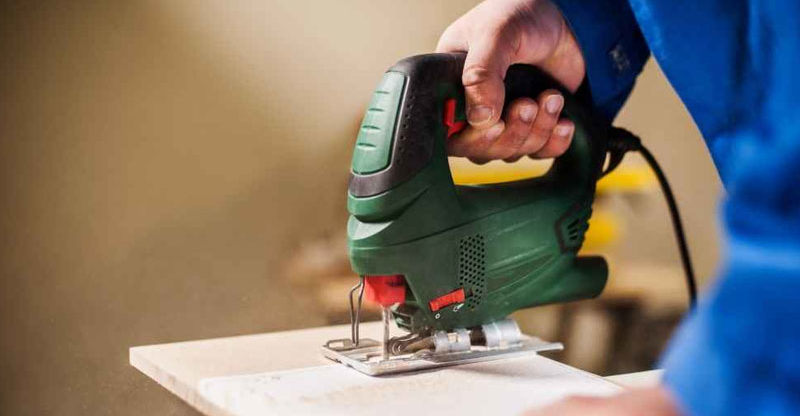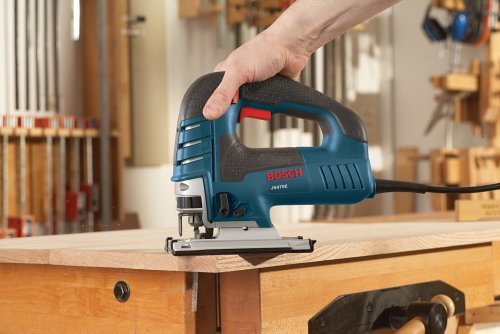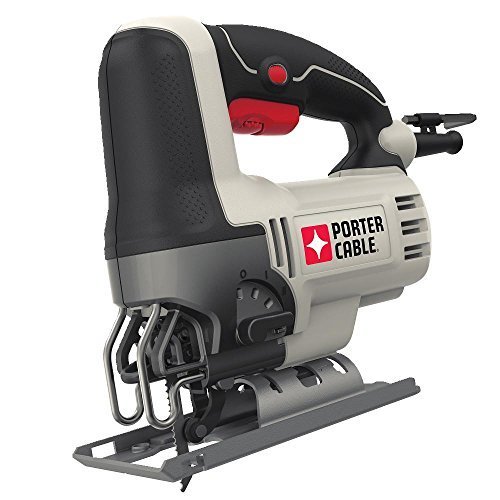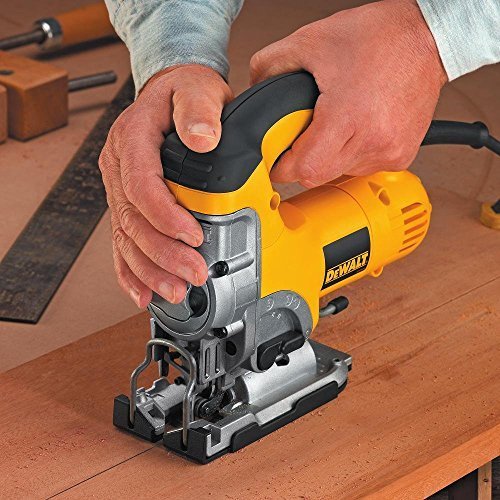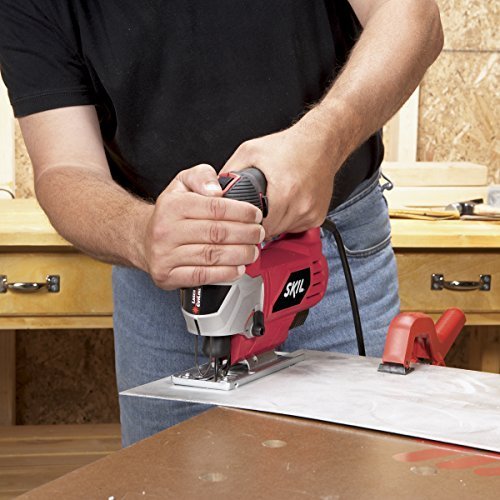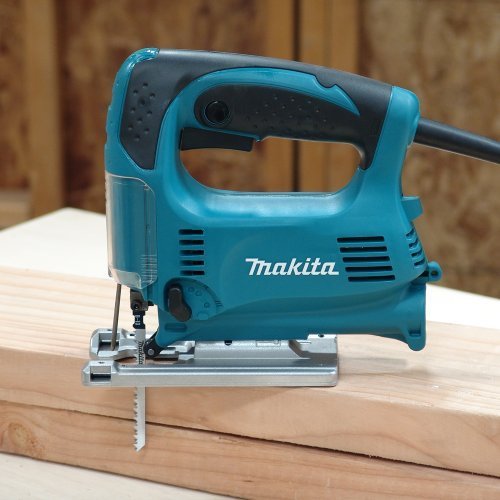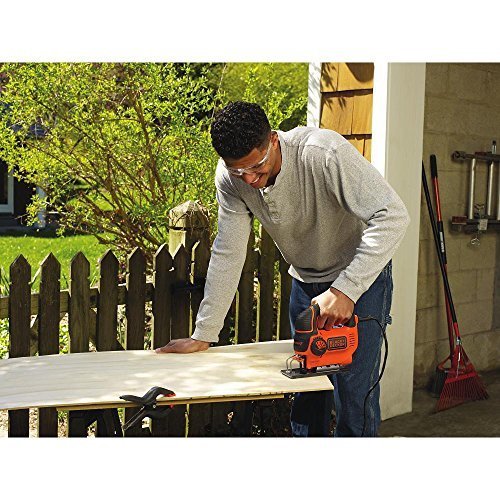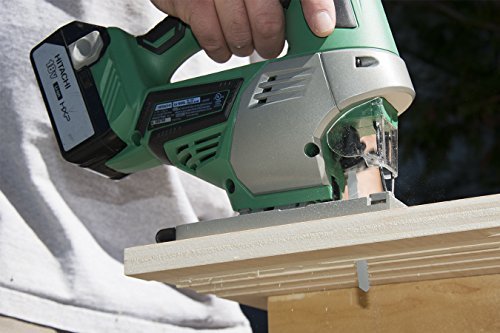7 Best Jigsaw Reviews & 19 Unavoidable Factors to Consider
When you’re inside the workshop, you will need a wide variety of tools to be accessible at all times.
Can you get away with having a limited roster of tools? Sure, but you also shouldn’t be surprised then if the project you’re working on doesn’t turn out exactly how you envisioned it inside your head.
One tool that definitely deserves a place in your workshop is the jigsaw. The jigsaw’s ability to provide precise curved cuts is extremely valuable inside a workshop.
If you’ve never had the pleasure of working with a jigsaw before, trust us, you won’t regret your decision to get one and you will likely be holding it in your hand on a regular basis.
Now, if you have worked with a jigsaw before, then please stick with us too as we’ll help you identify the best jigsaw currently available and also give jigsaw reviews.
Which One is the Best Jigsaw?
A good jigsaw is highly versatile and capable of working with a wide variety of metals. However, you can’t argue with the fact that jigsaws are simply at their best when they are used to slice through pieces of wood.
There are some hobbyists who are not completely pleased with jigsaws because they think of their blades as thin and flimsy. We’ll get into the concerns that come with using jigsaws in a bit, but the reality is that whatever issues may arise become less imposing if you’re using them to cut through wood.
Wood is sturdy, but any quality jigsaw should have no trouble working through that material in relatively quick fashion.
Even if we take into account the possible problems that come with using a jigsaw, it’s still well worth getting one for your workshop.
No other tool can produce the same quality curved and bevel cuts that are made possible by the jigsaw.
On top of that, jigsaws can also be portable. Many power tools in the workshop are on the heavier side and are a chore to move around. Jigsaws don’t fit that description.
Also, if you’re just starting out with woodworking, a jigsaw is a great tool to have on hand given how easy it is to use.
Image | Name | Editor's Rating | Price |
|---|---|---|---|
 | Bosch JS470E Variable Speed Top-Handle Jigsaw | 5 out of 5 | |
 | Porter-Cable PCE345 Orbital Jigsaw | 5 out of 5 | |
 | DeWALT DW331K Top-Handle Jigsaw | 4.5 out of 5 | |
 | SKIL 4495-02 Orbital Action Laser Jigsaw | 4 out of 5 | |
 | Makita 4329K Variable Speed Top-Handle Jigsaw | 4.5 out of 5 |
Now let’s us discuss about the best jigsaw reviews to make a perfect decision.
1. Bosch JS470E Variable Speed Top-Handle Jigsaw
The Bosch brand is recognized by many hobbyists and professionals alike all over the world. They have a reputation for delivering high-quality products and their Variable Speed Top-Handle Jigsaw can be counted among those.
The JS470E is a 4-in-1 orbital action tool. The availability of the different blade strokes gives users the ability to calibrate this jigsaw specifically to their needs.
Making it easier for users to get a grip on this jigsaw is the low-vibration design. Grip it firmly and you can execute extremely precise cuts. That precision becomes even more important when you are trying to complete curved cuts.
It’s sturdier than most jigsaws thanks to the way it has been constructed. Of particular note is the multi-directional clamp that gives this product added stability.
The name of this product tips off its biggest selling point. With variable speed included, you are given the chance to control the quality of cuts that will be provided by this jigsaw. Dial back the speed if you are looking to make an exact cut.
Complaints about the performance of this Bosch jigsaw are hard to find because it does its job so well.
The only thing that may realistically give you pause when considering purchasing it is the price. The price may be deemed too steep for many hobbyists, but if you know you’ll be using a jigsaw often, this is a good item to invest in.
While the previous item from Bosch will require a significant financial investment from you, the folks at Porter-Cable are offering you a more cost-effective option with their Orbital Jigsaw.
In addition to the lower price tag, the PCE345 Orbital Jigsaw from Porter-Cable features multiple speed and orbital settings as well as a 6-amp motor that provides more than enough power. Also included in this jigsaw is a lock-on button that makes it easier for users to keep on working with it even during marathon sessions in the workshop.
I like the numerous cutting options that you can try out when using this jigsaw. Four orbital settings are available so you can get varying types of curved cuts. The 7-position speed dial gives you varied options as well. That feature will come in very handy if you are going to be working with different materials or even just pieces of wood that vary in terms of thickness.
Be warned though, the trigger on this jigsaw is quite sensitive. If the project you’re working on requires a delicate touch, be light on the trigger to avoid making a mistake. I also find that it struggles a bit with precision even with the availability of the different speed options, at least relative to the other top rated jigsaws available.
Next up on this list of jigsaws is a DeWALT offering that prides itself on being powerful. Through my experiences of working with jigsaws, I’ve found that a 6-amp motor is more than capable of getting the job done, which is why I was intrigued by the 6.5-amp motor powering this DeWALT machine.
So, do you really need all that power? It depends. If you’ll be working exclusively with wood, the more powerful motor is a luxury more than anything. However, if you’re considering working with different materials sometime in the near future, the 6.5-amp motor may be exactly what you need.
Variable speed and different orbital settings are once again provided.
There’s also a dust blower included that is supposed to help keep the cutting lines visible whenever you’re working. It doesn’t always work as intended though and there are times when the dust particles are just blown all over the place.
The manufacturers decided to include features designed to keep users more comfortable such as the oversized rubber grip and the counterbalancing mechanism.
Those are necessary additions.
Even with those comfort-focused features included, I found working for an extended amount of time with this jigsaw to be quite tiring.
I personally don’t think that getting a jigsaw is a bad idea even if you won’t use it all the time, but if you are wary of investing too much into a product too quickly, then it may be worth your time to take a closer look at the Orbital Action Laser Jigsaw from SKIL.
It has all the modern features you would expect from a modern jigsaw, including variable speed and orbital control. This jigsaw also features a motor that is suited for working on wood and other materials.
To see such a feature-rich jigsaw offered at this price level is somewhat surprising. That’s what makes this product a good value proposition and an option that should certainly be considered for those not used to working with jigsaws.
The manufacturers also like to draw quite a bit of attention to the fact that this jigsaw comes with a built-in laser guide that is supposed to help you execute more accurate cuts. The issue is that the laser guide is not actually that helpful. You’re still better off relying on other tools to ensure that you’re making the right cuts.
Its performance in general is also a step behind what other best jig saws can offer, but again, the price tag attached to it makes it a sensible purchase for folks starting out.
Jigsaws are supposed to excel at making precise curved cuts. But of course, certain jigsaws do that job better than others, with the Variable Speed Top-Handle Jigsaw from Makita being among them.
Executing more precise cuts is easier to pull off while using this jigsaw due in part to the way it has been designed. It gives you a pretty clear sightline of the surface you’re working on while you’re using it. Built-in lights and lasers are no longer necessary because of that.
The lock-on button and oversized trigger make using this particular jigsaw even easier.
Multiple orbital settings are still offered along with this jigsaw, although the available options are not quite as varied as what you would see in the items mentioned previously in this article.
The motor is also not where you usually see it at. At just 3.9 amps, the motor powering this jigsaw lags well behind some of the top options that are currently available.
As much as possible, you should only use this jigsaw for thinner pieces of wood, though it can still work through thicker planks if given more time.
One more reason to limit the usage of this jigsaw to thinner pieces of wood is that its durability leaves a lot to be desired.
I was a bit surprised to see that the folks at Black + Decker are offering a best budget jigsaw considering that their loyal customers would probably be willing to pay a premium. Nonetheless, I came away impressed from my experience of working with their Smart Select Jigsaw.
Black + Decker did not skimp on the features for this particular jigsaw. It can definitely be considered a modern jigsaw in terms of its feature set.
The 5-amp motor used in this jigsaw is surprisingly powerful. When you crank it up, it is capable of breezing through wood. However, there is a trade-off for that power. If you do decide to use this jigsaw at the highest setting, it will be significantly tougher to achieve precision cuts. It struggles as a finishing item because of that.
The wire guard helps a bit with improving the quality of the cuts, but it would still be best for you to pull back on the power if you need to be as precise as possible.
You may also experience some difficulty trying to use this jigsaw thanks to how short its wire is.
Overall, you’re still getting great value if you choose to purchase this Black + Decker jigsaw, but you’ll find better performing jigsaws.
The last item we’ll discuss in this article is the Cordless Jigsaw from Hitachi. Above everything else, this Hitachi jigsaw specializes in offering users both comfort and convenience.
Let’s discuss the comfort-focused features first.
When I first picked up this jigsaw, I immediately noticed how well it fit into my hand. To say the handle is ergonomically-designed would be underselling it. You may notice how long you’ve been working by looking up at the clock in your workshop, but you won’t feel it in your hand.
As for convenience, you won’t have to move all over your workshop when swapping out blades to use in this jigsaw because there’s storage space built into this item already.
This jigsaw also doesn’t require you to stay within a certain space while you’re working because it’s cordless. There’s no need to constantly reposition yourself because you can work from any area you want.
An LED light is also included with this jigsaw and it will help you complete more precise cuts.
Of course, being cordless does come at a cost. In the case of this jigsaw, it ends up sacrificing top-end power to provide you with added convenience. In my opinion, that trade-off is fair and I’m glad to see that being cordless does not adversely affect this jigsaw in any other noticeable ways.
The Basics of the Power Tool Known as the Jigsaw
The jigsaw is not the most ubiquitous power tool, which is a shame, considering how useful it is.
Above everything else, the purpose of the jigsaw is to complete curved cuts. It is also used often to make irregular cuts – ones that would almost be impossible to pull off if you were just using a plain old circular saw.
Jigsaws make use of what is known as a reciprocating blade. The blade moves up and down once the jigsaw is activated. That’s actually one of the reasons why a jigsaw is such a nice item to have in your workshop.
Because of the way it slices through materials – it does so while the blade is moving up and back into the jigsaw – it is safe to work with even if you have no previous experience of doing so. It is worth noting that there are some jigsaws out there that cut while moving down. They are still safe to work with, but I personally prefer the more conventional models.
Jigsaw blades vary in terms of their size and design. The smaller quarter-inch blades are good for all kinds of applications, but the half-inch blades work better for larger items. You should also bear in mind that certain jigsaw blades are better suited for cutting wood, while others work best for harder materials.
The Features You Need to Look for in Jigsaws:
The majority of jigsaws have the same feature sets, but there are still factors that differentiate them from one another. Below, we have listed some of the features you’ll commonly find on the best jigsaws.
1. LED Lights/Laser Guide
LED lights and lasers are probably not features you would expect to see on a cutting tool, but they are definitely helpful. On jigsaws, the lights and/or lasers essentially guide you along whatever material it is you’re cutting. It’s easier to be precise with the help of the lights and/or lasers.
2. Dust Blower
As you can imagine, working with a jigsaw results in a lot of sawdust being produced. Having to constantly wipe away that sawdust to keep the surface you’re working on clean can be annoying. If the jigsaw you’re using has a dust blower, then you don’t have to worry about piles of sawdust accumulating anymore.
3. Blade Guide
Mistakes when you’re trying to make precise cuts with the jigsaw are unacceptable. To further decrease the chances that you’ll make a mistake while cutting, you should get top rated jigsaws that comes with a blade guide bearing. The bearing keeps the blade where it needs to be and it will make executing precise cuts easier.
4. Metal Base
There’s nothing worse than a jigsaw that moves when it’s working. If you get one that comes with a metal base, then you won’t have to worry about the jigsaw moving slightly while in use.
5. Powerful Motor
Jigsaws are designed to be precise, but they can be powerful as well. By getting one with a powerful motor, you can speed up the progress of your projects. A 6-amp motor is more than adequate for a jigsaw, but don’t hesitate to use one with a powerful motor if such an item is available.
19 Things You Must Know Before Selection
As we’ve already established, jigsaws are power tools that absolutely belong in any workshop. Yes, their primary purpose is for creating curved cuts, but even beyond that, they are highly useful because they can slice through a wide array of materials and are quite easy to work with.
We do know that shopping for a best jigsaw is no easy undertaking. With the sheer number of options available on the market, shopping for the right one can be intimidating.
It frankly doesn’t help that jigsaws are typically loaded with all kinds of features, which makes it difficult to determine the ones that are going to make a real impact on its performance level.
Information overload is a real problem when shopping for a best rated jigsaw, but we want to help you out. We’re still giving you a lot of information to process, but we’re going to present them in bite-sized chunks to make them easier for you to digest.
1. What’s up with the Jigsaw Blade?
Jigsaw blades are not one and the same. In fact, the kind of jigsaw blade you ultimately decide to use will either significantly improve how the tool performs or it will adversely affect it to the point that it will take you more time to complete a project.
Essentially, what you need to remember when looking at the jigsaw blade is that it has to match up with the material you are planning to work on.
Wood and harder metals will bend easily to a bimetallic blade. If the material you’ll be working with is a thinner type of metal, then you can’t go wrong with a steel jigsaw blade. The thicker and tougher materials can be sliced through quickly by tungsten carbide blades.
You can choose an all-purpose blade if you want, but if you already know that you’ll mostly be working with just one type of material, it’s best to choose a more specialized blade.
2. Is There an Injury Risk When Using a Jigsaw?
No power tool can be guaranteed to be completely safe each and every time you use it. Weighty objects that are made out of metal that have blades can cause injuries if you mishandle them. That’s just how things work.
Even so, the injury risk with jigsaws is quite low especially when compared to other power tools. That’s due in part to how they work. To further reduce your risk for injury, make it a point to get a jigsaw that cuts on the upswing.
Some jigsaws also feature blade guards and solid metal bases. Those are features that ensure that the blade is right where it needs to be at all times and they will also keep you safe.
3. How Fast can Jigsaws Go?
Jigsaws rely on speed to get their job done and how quickly one can go will significantly impact its performance. Generally speaking, there are two things you need to look for when you’re trying to figure out how fast a jigsaw can work. To be more specific, you need to look at its motor as well as the upper limit of its strokes per minute, which is also known as SPM.
Let’s tackle the motor first. You should try to look for a 4-amp motor at the very least, but as much as possible, try to find one that is closer to six amps. The rule here is simple: If you want more power in your jigsaw, then go with the one that features the strongest motor. Some jigsaws have motors that exceed six amps. Those are the real powerhouses and they are ideally suited for working on the thickest materials.
Notably, not all jigsaw motors can be measured in amps. In fact, only corded jigsaws make use of amps to indicate how powerful their motors are. If you value mobility and would rather work with a cordless jigsaw, then you need to keep an eye out for the voltage. Once again, the higher the voltage, the more powerful the motor will be. An 18-volt motor will be fine for most applications, but there are some jigsaws that feature 20-volt motors.
As for SPM, this just refers to how quickly the blade is moving. You’ll be able to find a bunch of jigsaws with a top SPM count of 3000 although there are some that also exceed that threshold.
Of course, a jigsaw that can only go fast is no good. That’s why you also need one that features variable speed control so that you can adjust the jigsaw’s speed to better suit your project.
4. What about Pricing?
You can definitely find some good jigsaws that are available at an affordable price as discussed earlier in this article. However, they will often be missing some high-end features.
Even if you think that you’re not going to get plenty of usage out of a jigsaw, trust me, a good one will be helpful to you for a very long time.
Price should certainly play a role in which jigsaw you get, but it wouldn’t be the only thing I would look at.
5. Will Jigsaws Tire Out My Hands too Quickly?
One of the things I love about jigsaws is that they almost always come equipped with features focused on making users feel more comfortable. It may just be an ergonomically-designed grip or something else that minimizes vibration, but you’re certain to find at least a few comfort-focused features on jigsaws.
6. What about Warranties?
Thankfully, manufacturers are generally pretty good when it comes to offering warranties. At the very least, you should find one that comes with one year limited warranty that covers manufacturer defects.
Some manufacturers will offer to provide free repairs for a year and a limited warranty that lasts for a total of three years.
The cordless Hitachi jigsaw we talked about earlier comes with a lifetime lithium ion tool warranty.
7. Would a Budget Jigsaw Work for More Labor-Intensive Projects?
The truth is that best budget jigsaw have a lower ceiling in terms of performance. They are still quality products that offer you terrific value, but lacking that high-end power makes them ill-equipped to handle more than a few projects.
If you know that you’ll need plenty of power and durability from your jigsaw, don’t shy away from splurging.
8. What Type of Handle Should I Look for?
There are two types of handles that are used for jigsaws.
The first one is known as a barrel grip. Jigsaws with barrel grips are the ones that have extended handles. A jigsaw with a barrel grip almost looks kind of like a drill, except the drill bit is facing down and the handle is parallel to the ground.
Jigsaws also come with top handles. Top handles are also called D handles and that’s because the enclosed handle section resembles that letter of the alphabet.
You can’t go wrong with either handle type. I would advise you to just pick the one that feels the most comfortable in your hands.
9. Is It Important to Get an Adjustable Jigsaw?
Since the jigsaw specializes in making irregular cuts, it’s only natural that you’ll eventually have to use it to cut into irregularly shaped objects. That is exactly why you should go out and get a jigsaw that can be tilted and adjusted to accommodate the materials you’ll be working with.
Many jigsaws are even designed to stop at fixed angles so that they remain stable even as you approach a cut from an angle you’re not used to. Being adjustable is most certainly a feature that matters in a jigsaw and I would prioritize it.
10. Why Do I Need Variable Speed Control?
You want a jigsaw that can really pour on the power when it needs to, but at the same time, it also has to be capable of being less forceful when it is asked to. That is what variable speed control is for.
The materials you’ll be cutting will come in varied shapes and sizes and sometimes, you will need to slow down to make sure that you are making the proper cut. Variable speed control will help with that.
A jigsaw can feature anywhere from four to seven variable speed settings. Go with the ones that give you the most options.
11. What is the Laser Guide for?
The laser guide is there to help you see where you need to keep going with your current cut. From my experience working with jigsaws that have laser guides, the lasers tend to point in different directions and it can sometimes be confusing.
Laser guides work best when I am going along a relatively straight surface with my jigsaw. If that makes them sound relatively useless because jigsaws are meant for curved cuts, I wouldn’t necessarily agree with that assessment.
For the most part, laser guides allow you to work faster and that’s always helpful.
12. What about the LED Lights?
Similar to the lasers, LED lights are used mainly as guides during the cutting process. Drawing from my experience from working with jigsaws again, I’ve found that LED lights are generally more accurate. They come in very handy when you’re trying to navigate a tricky curve.
The downside to using LED lights is that they can be overpowered by other lights you have in your workshop. You may also have to deal with shadows and they can work to make things even more confusing.
If asked to choose between laser or LED guides, I would go with the latter.
13. Does Vibration Reduction Make a Difference?
They’re called power tools for a very good reason and sometimes, dealing with that much power can be challenging. To make things easier on yourself, you should try to find a jigsaw that comes with built-in vibration reduction.
Just so you know, you don’t actually have to go out of your way just to find a jigsaw that offers great vibration reduction. Most of the options available now already offer some form of vibration reduction via the grips.
I would also look into getting a jigsaw with a more stable metal base because that helps reduce the vibration a bit as well.
14. Why Do I Need the Trigger Lock?
Trigger lock is an underappreciated feature. It’s something you likely won’t prioritize, but trust me when I say that trigger lock will be your best friend once you start working with your jigsaw more often.
For those who may be unaware, the trigger lock essentially works to, well, lock the trigger in place. Trigger lock comes in handy when you want to continue cutting but also want to rest your fingers for a bit. Just lock the trigger into place and the jigsaw will keep going as you stretch out your hand.
Marathon sessions in the workshop are made so much easier by the presence of trigger lock.
15. Is the Tool-Less Blade Change Feature Something I Need?
Jigsaws are compatible with different blades because they need to be able to cut through a variety of surfaces. Because of that, it would not be ideal to get a jigsaw that requires you to go through a complicated process just to swap out its blades.
The good news for you is that there are jigsaws that come with a feature known as tool-less blade change. The name of the feature is pretty self-explanatory and usually, the process of swapping out jigsaw blades without tools will only take a few minutes at most.
16. What Should I Know about Jigsaw Blades?
The jigsaw blade is typically about a quarter of an inch wide and about 1/32-inch thick. You will see larger blades, but it is important to note that jigsaw blades vary not only in terms of their size.
We already talked earlier about how there are three types of jigsaw blades based on what materials they are best suited to cutting. Steel blades are best used for cutting thinner materials, while the bimetallic blades can capably handle wood and somewhat thicker pieces of metal. For the thickest materials, you will need a tungsten carbide blade.
Jigsaw blades also vary from one another in the way they cut. Some jigsaw blades cut on the upstroke, while others do so in the opposite direction. Stick to the jigsaw blades that cut upward because they are the safer options.
Flexibility is yet another feature of the typical jigsaw blade that makes it so remarkable. It’s that flexibility that allows the blade to perform curved cuts.
Unfortunately, you are sacrificing something in exchange for the jigsaw blade being flexible. Because of how flexible they are, maintaining jigsaw blades can be quite the ordeal. Keeping the teeth of the blade in proper working condition will require a lot of diligence on your part and even then, you may end up making some mistakes.
It doesn’t help that simply using the blades to make your cuts can result in them being warped.
Here’s some good news for you though: Most jigsaw blades are relatively inexpensive. If you’re having a lot of trouble simply keeping them sharp, then it may be a better idea for you to get more replacement blades.
It’s a good idea to get multiple replacement blades of varying types so that you are maximizing them with every use. Stock up on the blades in your workshop and you won’t have to worry about your jigsaw being out of commission for an extended period of time.
17. What is a T-Shank Blade?
T-shank blades are what you’ll often find in jigsaws and yes, they are named after the way they look. T-shank blades are also more versatile and they can be swapped out in a hurry.
18. What is a U-Shank Blade?
U-shank blades are not quite as versatile as the T-shank variants. On top of that, they are harder to replace and you will likely need some assistance from an Allen wrench.
19. What are Some Extra Steps I Can Take to be Extra Safe When Using the Jigsaw?
First and foremost, make it a point to familiarize yourself with the jigsaw you are using. Take the time to check if you are using the right blade and if the jigsaw can handle the task you are asking it to perform.
You should also try to clamp down whatever it is you’re cutting to prevent accidents. Jigsaws produce vibrations and they could cause the material you want to cut to fall off a table or something like that.
It’s also best to avoid touching the blade right away after you turn it off unless you don’t mind getting burned.
How Jigsaw Works?
Jigsaws are remarkable machines. They are capable of making complex cuts while remaining easy to use and safe at the same time. They manage to do that because their blades do the cutting while not putting any part of your body in harm’s way.
Jigsaws can do their job even better if you maximize their capabilities. That involves using the right blades for cutting through the right materials and also figuring out which speed setting works best. The type of motor that is featured inside the jigsaw will also significantly affect how it performs and if you want optimum performance, you should look for the most powerful ones available.
1. Learning More about the Jigsaw Motor
If there is one thing you absolutely need to look for in the motor that will be powering your jigsaw, it is its ampere rating for the corded variants and the voltage rating for the cordless options.
When it comes to the ampere rating, you should try to find a jigsaw motor that at least provides four amps. That type of motor is suitable for the majority of DIY applications, although it is admittedly lacking if you have some heavy duty projects in mind. Still, for most hobbyists, that type of motor will work for you.
For hobbyists, a cordless jigsaw that has an 18-volt motor will likely be enough, but one with a 20-volt motor is what you will want for heavy duty applications.
2. Contemplating Which Grip is for You
The grip is not necessarily going to greatly affect the performance of your jigsaw, but it can influence the kind of experience you have while spending time in your workshop.
The top-handle or D-handle grips require you to grasp the jigsaw from above, meaning you’re looking down on the material you’re cutting. Barrel grips are held from one side and they tend to feel more natural because they resemble the handles used on many other power tools.
You can’t go wrong with either one, so just choose which one you are more comfortable with.
How Cordless And Corded Jigsaws Differ From One Another?
You would think that the only differences that exist between the cordless and corded jigsaws is the way they are powered and that one provides more range of movement when you’re using it, but there’s more to it than that.
When trying to decide whether a cordless or corded jigsaw is better suited for you, you will inevitably also have to consider the cost.
For the most part, the corded jigsaws are significantly less expensive than their cordless counterparts. The cost differential becomes even larger when you have to factor in the added cost of batteries.
That difference in pricing is understandable considering how valuable that added convenience is.
Choosing Between Sole Plates
The sole plate is an important part of the jigsaw and there are three choices for you to choose from.
The first type of sole plate is made out of pressed steel. What I love about these pressed steel sole plates is how durable they are. They can stay on your jigsaw for a long time as long as you don’t drop them. Once a steel sole plate has been dropped and damaged, you may have no other choice than to replace it.
Conversely, cast aluminum sole plates have greater resistance to drop damage and any bumps they do sustain can be addressed with a sander. You will notice the wear and tear on cast aluminum sole plates earlier though.
If you have some money to spare, you may want to get a jigsaw that features an aluminum base with a steel insert. That option brings you the best features of the pressed steel and cast aluminum sole plates.
The Jigsaws Limitations
Jigsaws are versatile enough to execute a wide array of cuts. You can make use of them to cut straight through materials if you want to and of course, they specialize in making those curved and irregular cuts.
Just in terms of cutting versatility, you can make the case that jigsaws outshine any other power tool. That is not the case when it comes to their cutting capacity however.
Because of the way jigsaws are designed, they simply cannot match the cutting capacity of other types of saws.
Even the higher end jigsaws may only be able to cut cleanly through materials that are about five inches thick. Anything beyond that and you would be pushing the jigsaw blade to its limit and it may sustain long-term damage.
The majority of jigsaws can capably cut through materials that are around two to three inches thick. You may think that a maximum cutting capacity like that is lacking, but believe me, it is more than suitable for a large variety of applications and projects.
By adhering to the appropriate cutting capacity of your jigsaw, it should be able to provide quality cuts for an extended period of time and it will also remain in fine working condition long-term.
Other Interesting Tidbits about Jigsaw Blades
We’ve already gotten into which types of jigsaws blades are best suited for cutting certain materials and we’ve also shined a light on how they differ in terms of their shape, but that’s not all you need to know about jigsaw blades.
For instance, shopping for a best jig saw blade can be a significantly more pleasant experience than you expect it to be. One reason why is because jigsaw blades are quite inexpensive. You can keep a stock of replacement jigsaw blades in your workshop if you want to save up on trips to the hardware store. You can even keep varied blade types if you want to and the cost of doing so will still not be prohibitive.
Shopping for blades is also made easier by the fact that the manufacturers will help you out. Replacement jigsaw blades are usually labeled, with the manufacturers telling you which materials a specific blade can cut.
The teeth per inch (TPI) count is another thing you may want to look at when shopping for a jigsaw blade. In general, 12 TPI will be adequate for jigsaw blades that are going to be used for cutting wood. Higher TPI counts are required for tougher materials.
More Things to Look for When Shopping for A Jigsaw
Compared to other power tools that are commonly used in the workshop, jigsaws are quite friendly to users. Once you’ve read the manual, you should know everything you need to about how to properly deploy them. However, there are still other jigsaw features that can make it even more user-friendly.
Guiding LED lights and lasers are common features in jigsaws. I would lean towards getting the jigsaws with LED lights as opposed to lasers just because I believe the former does a better job of telling me where I need to cut.
Jigsaws that also come with dust blowers included are more convenient to use. Dust blowers are useful because they clear the way for your cutting. Instead of having to constantly stop and start to wipe away the dust on your cutting surface, the dust blower can handle that for you and you can be more efficient with your time in the workshop.
You may also find jigsaws with blade guides. Those features will similarly improve the quality of your cuts.
It’s also worth checking if the jigsaw you’re getting comes with a protective case. You don’t want your new purchase getting all dirty and damaged just days after you got it. Having a case to keep the jigsaw in will eliminate that problem.
Typical Prices for Jigsaws
There are three pricing levels for jigsaws, or at least that’s what I’ve noticed over the years of shopping for them.
I should note here that I’m only accounting for jigsaws that come from reputable makers because those are the ones you should be getting anyway if you don’t want to waste your money.
The most affordable ones now hover around $40 to $50 bucks. These corded jigsaws still come loaded with the essential features and will last for a while in your workshop with proper care. They’re often lacking in high-end power though.
Corded jigsaws that are priced somewhere around $120 to $150 have all the features you need, significantly more powerful engines as well as some add-ons that make them easier to use.
The best cordless jigsaws are the ones that can really make a dent in your bank account. These jigsaws are usually priced around $250 to $300. The price tag is high, but it’s worth it if you have the money.
Lastly, some cordless jigsaws are closer in terms of price to the premium corded variants. Manufacturers are able to lower the price by that much typically because those cordless jigsaws don’t come with batteries included.
Essential Tips for First-Time Jigsaw Buyers And Users
Let go of the idea that you may be wasting money by spending a significant amount to get a jigsaw made by a reputable manufacturer. A good jigsaw will be a mainstay in your workshop and any hobbyist will be able to get good mileage out of it.
Variable speed and orbital settings are must-haves in any jigsaw. Don’t even think about getting a jigsaw that lacks those settings.
You don’t always need to have the jigsaw’s power turned up to the max. In fact, in certain scenarios like navigating some tricky corners, going slow is recommended.
1. Will a Jigsaw be Able to Cut through Metal?
Most hobbyists like to use their jigsaws to fashion elaborate pieces out of wood. These power tools work exceptionally well in that regard. However, you shouldn’t feel any need to limit yourself to just using jigsaws on wood.
For instance, metal is another material that jigsaws can work through with relative ease.
Perhaps you’ve heard some horror stories about jigsaws being used on sheets of metal only for poor results to be produced. In all likelihood, the hobbyists in those scenarios simply forgot to use the right blade for cutting through metal.
As I’ve mentioned a few times previously in this article, one of the ways to maximize the performance of your jigsaw is to make sure that you have the right blade in place. It doesn’t matter how powerful your jigsaw is, if you’re using the wrong type of blade to cut through a certain material, then the end result will be something you’re not happy with.
So, going back to the question of whether a jigsaw can cut through metal, the answer to that is a resounding yes.
When it comes to metal, you need to also account for how thick it is. For thinner sheets of metal, you will need to have a steel blade working inside your jigsaw. Larger slabs of metal can be processed properly using bimetallic and tungsten carbide blades.
To further increase your chances of successfully cutting through metal using the jigsaw, you can first place the sheet of metal in between two layers of plywood. Go ahead and drill a hole through the metal as well. You can now use that hole as the entry point for your cut.
That trick is useful for all kinds of metal, although it does work better on thicker pieces.
2. Will I be Able to Use a Jigsaw to Cut through Laminate Flooring?
Jigsaws can absolutely be used for cutting up sheets of laminate flooring.
To do so, you should first shop for the right jigsaw blade. You should be able to find replacement blades that are clearly labeled to be used for laminate tiles. Don’t worry about the pricing as these blades are inexpensive.
With the new blade in your possession, simply install it in your jigsaw and then go ahead and start cutting. Laminate materials are on the thinner side and they should be easy to handle for any quality jigsaw.
3. Will I be Able to Use a Jigsaw to Cut through Kitchen Tiles?
Kitchen tiles are strong materials and they are also typically on the denser side. That means jigsaws aren’t going to work on them, right?
Jigsaws can in fact still be used to process kitchen tiles and because they produce curved cuts, they can even churn out some good end pieces.
Before you cut up any tiles though, make sure that you have a tungsten carbide blade inside your jigsaw. You will need the sturdiness that type of blade provides.
I would also grab some cutting oil and apply that to the blade as that will make cutting through the tile significantly easier.
4. Will I be Able to Use a Jigsaw to Cut through Plastic?
It’s a no brainer, right? If jigsaws can cut through wood, metals, and even ceramics, then it should have no trouble working on plastic. Obviously, yes, jigsaws can be used to cut through plastic, but there are things you need to keep in mind before doing that.
Remember that plastic tends to melt when exposed to high temperatures. To prevent the plastic you’re cutting from melting, you should dial back on the power.
Set the jigsaw on one of the slower variable speed settings and let the teeth do most of the cutting.
3 Types of Woodworking Jigsaws You Need to Know
1. The Corded Jigsaw
Corded jigsaws are great options to consider for folks just getting into woodworking. They are priced very reasonably and using them is by no means challenging. Corded jigsaws are not suitable for all types of working locations, but if you’ll be doing your woodworking at home, feel free to get one of these machines.
2. The Cordless Jigsaw
Powerful, versatile, and convenient, the cordless jigsaw is everything you can ask for in a power tool. These tools can go everywhere with you and you don’t even have to worry about the quality of your work suffering. The only real downside to the cordless jigsaw is its cost, but this power tool is still worth the asking price.
3. Pneumatic Jigsaw
Pneumatic jigsaws are the most powerful variants of this particular power tool. It’s unlikely that you’ll ever need the type of power they can offer if you’re just working on your own projects however.
Frequently Asked Questions
1. Does Type of Power Sources Make a Difference?
Answer: Jigsaws that you have to plug in are usually more powerful and it’s also a nice bonus that you don’t have to worry about them running out of juice while you’re in the middle of something. If convenience is more important to you though, then you’ll want the battery-powered jigsaws.
2. Is Blade Size Something That Can Alter the Performance of the Jigsaw?
Answer: Because of the way the jigsaw is designed, you can’t just go out and get any type of blade and feel confident that it will work fine.
For example, if the blade you chose for your jigsaw is too small, then it may struggle to cut into the material. You don’t want to double back and repeat cuts because that would risk damaging the material you’re working with.
Jigsaw blades that are too long may struggle with accuracy and are also tougher to control.
Always remember to get a blade that fits your jigsaw properly if you want a good outcome.
3. What is the Pendulum Motion for?
Answer: Some jigsaws boast that they feature pendulum motion and to be fair, that is something worth drawing attention to. Jigsaws that follow a pendulum motion are less prone to getting stuck and they are also safer to use because they move away from you and into the material that needs to be cut.
4. What’s a Good Maximum SPM Rating for a Jigsaw?
Answer: Most of the jigsaws you’ll see on the market today have a maximum SPM rating of around 3000. Fortunately enough, 3000 SPM is likely more than what you’ll need for most of your projects. Just remember to lower the variable speed setting if you need a lower SPM rating.
5. What is the Hidden Value of the Orbital Setting?
Answer: A jigsaw cannot be considered a quality power tool if it does not feature an orbital setting.
The orbital setting contributes positively to the performance of a jigsaw in a few ways.
First, the orbital setting will make it easier for a jigsaw to slice through thicker materials. Engaging the orbital setting changes the way the blade moves. It doesn’t just move down and up anymore. With the setting activated, the blade will instead move slightly into the material as it moves up during the cutting process.
That movement makes it easier to cut through thicker sheets of wood, metal, and other materials.
Furthermore, the elliptical motion of the blade also results in the cut becoming cleaner.
6. Why Should I Look for an Adjustable Base Plate?
Answer: Stability is not the only thing you need from a jigsaw base plate. It also has to be adjustable so that angled cuts are easier to execute.
7. Is the Laser Guide Important to Have in a Jigsaw?
Answer: The truth is that you don’t need the laser guide in a jigsaw, especially when LED lights actually do a better job of telling you where to move next.
8. Do I Need That Special Safety Mechanism in My Jigsaw?
Answer: It’s always best to err on the side of caution whenever you’re working with power tools and that holds true even for experienced hobbyists. If possible, try to find a jigsaw that has a safety lock. When used, this feature will keep the blade from moving and save you from a potential accident.
The jigsaw is one of the best power tools you can get for your workshop.
Some may think of it as an unnecessary acquisition because it specializes in making curved and angled cuts, but once you’ve had the chance to work with one, it’s highly unlikely that you will want to continue without one of these machines in your workshop.
Considering how much they cost, there’s no real reason to avoid getting a jigsaw. Putting money down for a good jigsaw is one of the smartest moves you can make as a hobbyist, so find which one suits your needs best and add it to your collection of power tools.

